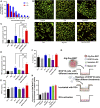An engineered hydrogel with low-dose antitumor drugs enhances tumor immunotherapy through tumor interstitial wrap
- PMID: 36452209
- PMCID: PMC9701709
- DOI: 10.3389/fbioe.2022.1072393
An engineered hydrogel with low-dose antitumor drugs enhances tumor immunotherapy through tumor interstitial wrap
Abstract
Stimulating immunogenic cell death (ICD) is the key to tumor immunotherapy. However, traditional chemoradiotherapy has limited effect on stimulating immunity and often requires repeated administration, which greatly reduces the tumor-killing effect. In this article, we created a sodium alginate hydrogel sustained-release system containing low-dose doxorubicin (Dox) and immune adjuvant R837, which were injected into the interstitial space to wrap around the tumor in situ, achieving a sustained release and long-lasting immune response. Cooperating with immune checkpoint blockade, Dox induced ICD, activated dendritic cells (DCs) and converted immunosuppressive M2-type tumor-associated macrophages (TAM) to tumor-killing M1-type TAMs. Simultaneously, it greatly promoted T cell proliferation and infiltration, and reduced tumor immunosuppressive factors, triggering a robust immune response to suppress tumors in vivo. In conclusion, this anti-tumor strategy based on interstitial injection can achieve continuous local immune stimulation by low-dose chemotherapy drugs, providing a potential approach for tumor immunotherapy.
Keywords: hydrogel; immunogenic cell death; interstitial administration; tumor immunotherapy; tumor microenvironment.
Copyright © 2022 Li, Xiang, Zhang, Zhao, Meng, Zhong, Li, Jia, Li, Lu, Ao and Han.
Conflict of interest statement
The authors declare that the research was conducted in the absence of any commercial or financial relationships that could be construed as a potential conflict of interest.
Figures







Similar articles
-
Repolarizing Tumor-Associated Macrophages and inducing immunogenic cell Death: A targeted liposomal strategy to boost cancer immunotherapy.Int J Pharm. 2024 Feb 15;651:123729. doi: 10.1016/j.ijpharm.2023.123729. Epub 2023 Dec 22. Int J Pharm. 2024. PMID: 38142016
-
In situ chemoimmunotherapy hydrogel elicits immunogenic cell death and evokes efficient antitumor immune response.J Transl Med. 2024 Apr 9;22(1):341. doi: 10.1186/s12967-024-05102-0. J Transl Med. 2024. PMID: 38594751 Free PMC article.
-
Charge-switchable nanoparticles enhance Cancer immunotherapy based on mitochondrial dynamic regulation and immunogenic cell death induction.J Control Release. 2021 Jul 10;335:320-332. doi: 10.1016/j.jconrel.2021.05.036. Epub 2021 May 29. J Control Release. 2021. PMID: 34062192
-
Tumor Microenvironment-Activatable Prodrug Vesicles for Nanoenabled Cancer Chemoimmunotherapy Combining Immunogenic Cell Death Induction and CD47 Blockade.Adv Mater. 2019 Apr;31(14):e1805888. doi: 10.1002/adma.201805888. Epub 2019 Feb 14. Adv Mater. 2019. PMID: 30762908 Review.
-
Tumor-Targeted Nanomedicine for Immunotherapy.Acc Chem Res. 2020 Dec 15;53(12):2765-2776. doi: 10.1021/acs.accounts.0c00518. Epub 2020 Nov 8. Acc Chem Res. 2020. PMID: 33161717 Review.
Cited by
-
Nanocarrier-Mediated Immunogenic Cell Death for Melanoma Treatment.Int J Nanomedicine. 2023 Dec 1;18:7149-7172. doi: 10.2147/IJN.S434582. eCollection 2023. Int J Nanomedicine. 2023. PMID: 38059000 Free PMC article. Review.
-
Hydrogel drug delivery systems for minimally invasive local immunotherapy of cancer.Adv Drug Deliv Rev. 2023 Nov;202:115083. doi: 10.1016/j.addr.2023.115083. Epub 2023 Sep 9. Adv Drug Deliv Rev. 2023. PMID: 37673217 Free PMC article. Review.
References
-
- Cao Y. P., Hu X. J., Zhang Q., Hua W. D., Hu N., Nie Y. F., (2020). Intervaginal space injection of a liquid metal can prevent breast cancer invasion and better-sustain concomitant resistance. Mat. Chem. Front. 4, 1397–1403. 10.1039/c9qm00753a - DOI
LinkOut - more resources
Full Text Sources

